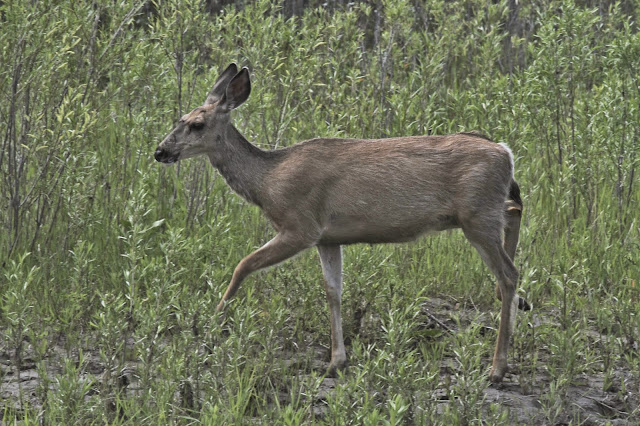Hoary Marmot - Marmota caligata
The name, "hoary," refers to the "mantle" of white hairs over the shoulders. These mammals are the largest marmot in Canada.
Hoary Marmots are colonial and live together in burrows where they share food. They often sun themselves in shallow depressions on rocks close to their burrow. They vocalize a loud, high-pitched alarm whistle when a predator is recognized.
Predators include Coyote, Wolf, Grizzly Bear, Red Fox, and Golden Eagle.
Reference
Naughton, Donna. The Natural History of Canadian Mammals. University of Toronto Press. 2012.
Mule Deer - Odocoileus hemionus
The larger ears and the black tip to the tail are two common clues that distinguish a Mule Deer from the more common White-tailed Deer. Both species live in the area where I hike. The hoof prints and the scat are similar.

References
Gadd Ben. Handbook of the Canadian Rockies. Corax Press. Jasper, Alberta. 1986.
Naughton Donna. The Natural History of Canadian Mammals. U of Toronto Press. 2012.
Muskrat - Ondatra zibethicus
Muskrats are the largest and the most aquatic of the voles in North America. These rodents are not closely related to the beaver, although both mammals have evolved similar physical and behavioural adaptations to their shared environment.
Muskrats do not hibernate. The photo above shows a muscat feeding on the ice at the side of a slough (runoff pond) close to the Elbow River.
Muskrats usually feed within 60 meters of their burrow, which allows a high population density in an optimal environment. The population cycles with peaks every eight to ten years. Mink are common predators and the population of this carnivore tends to track that of the Muskrat.
The skull bones in the photos are likely muskrat. I found the bones in the grass about 20 meters from a runoff pond below my home. The muskrat was likely attacked by a predator either while swimming or while grooming or eating by the edge of the pond. The predator likely carried the muskrat into the tall grass to eat.
The pond is home to muskrats. The average litter ranges from 5 to 9 kits. In the fall of 2008 I counted 9 muskrats in the pond at one time. The large number was likely the result of a successful spring litter. Since then I have never seen more than two at a time. Common local predators include coyote, domestic dog, bobcat, mink, larger raptors, and man.
Reference
Naughton, Donna. The Natural History of Canadian Mammals. U of Toronto Press. 2012.
Black-capped Chickadee - Poecile atricapilla
Black-capped Chickadees are prevalent year round in the Calgary area.
Specialized leg muscles enable these birds to feed upside down while hanging from a perch. They are adept at exploiting resources in difficult situations. Food is stored in caches and used during the winter when resources are meager. During very cold winter days chickadees are able to lower their body temperature (regulated hypothermia) from 42 C to 30 C to conserve energy.
Chickadees will pester predators (mobbing behaviour) that are in their territory.
In autumn the new chickadees leave their parents and join a flock with which they will overwinter. These chickadees will mate the next spring with a member of the flock.
The nest is often a cavity in rotten wood. In my neighborhood, the chickadees favor creating cavities in the exterior of a home. They choose a location under the eaves where they excavate into the soffit where the siding meets the roofline.
References
1. The Atlas of Breeding Birds of Alberta. Federation of Alberta Naturalists. 2007.
2. Baicich PJ, Harrison CJO. Nests, Eggs, and Nestlings of North American Birds. Princeton UP. 2005.
3. Sibley David A. The Sibley Guide to Bird Life & Behavior. Alfred A Knopf, Inc. New York. 2001.

